Chelsea have been one of the more underwhelming teams in the Premier League this season. From their slow start under Thomas Tuchel to their continued frustrations under Graham Potter, Chelsea’s season has been one to forget so far.
This club is under a rebuild, which has meant that everything is in transition, whether that’s the staff behind the scenes or the tactical display on the pitch. After 17 Premier League games, they have only managed to score 20 goals and clearly lack both creativity and goal scorers. No one in the team has the killer instinct within them, or the hunger to get onto the end of a chance, which has been made evident during both open play and from set-pieces.
In the Premier League, Chelsea rank bottom for xG amassed from set plays with a value of 2.23. They have scored three goals from these situations, a Mason Mount free kick, a second-phase header from Havertz, and a Koulibaly volley. Since Graham Potter arrived at the club, Chelsea are yet to score directly from a delivery into the area from a set piece in the league, which is unacceptable after 11 games in charge. It has to be said that they have scored one against AC Milan in the UEFA Champions League.
Furthermore, Chelsea have the worst corner-to-shot ratio in the Premier League, with Chelsea players only getting a shot off from corners 33.73% of the time. From 83 corners, Chelsea have 1.56 xG, and a total of 0.056 xG per shot with only Leicester having a lower value for both statistics this season. This means that Chelsea regularly fail to create quality chances, and when they do get to a corner first, the quality of each chance is very low, meaning that it’s unlikely to ever result in a goal.
For the purpose of this tactical analysis, we will only look into Chelsea’s tactics during set pieces since Graham Potter’s arrival, to understand how they’ve performed under him, and how it may look going forward. This set-piece analysis will show how Chelsea set up from both corners and free kicks to determine the reasons for their poor record. We will also conduct an analysis of how and where Chelsea may look to improve in this area of the game.
Failure to create against zonal defences
The first area in particular where Chelsea have underwhelmed is through the positioning of their attacking players. Like with their tactics and line-ups, Chelsea continue to change what they do from corners as well. The continuous change in positions can and has produced a few quality chances, but usually results in players mistiming their runs and corner takers hitting zones which nobody runs to. This leads to a high number of corners just being turned over through a lack of cohesion as a team, and a lack of preparation.
However, there are times when Chelsea make the wrong decisions after planning their corners. For example, in the screenshot below, Ruben Loftus-Cheek (red) is used as a blocker, to allow the ball to arrive into the front of the six-yard box. The point of a blocker is to create space behind him. The problem is that Chelsea’s players (green) who are being man-marked, all move into the six-yard box before the corner is taken. When that move happens, every man marker moves into the six-yard box, which solves half of Arsenal’s problem for them.
Rather than being preoccupied with both runners from deep and players inside the six-yard box, Arsenal can now focus all their efforts on zonally marking the six-yard line, with no other Chelsea player occupying any other zone. As a result, the zone which is the target for the corner has been closed off by Chelsea, who shoot themselves in the foot through their positioning.
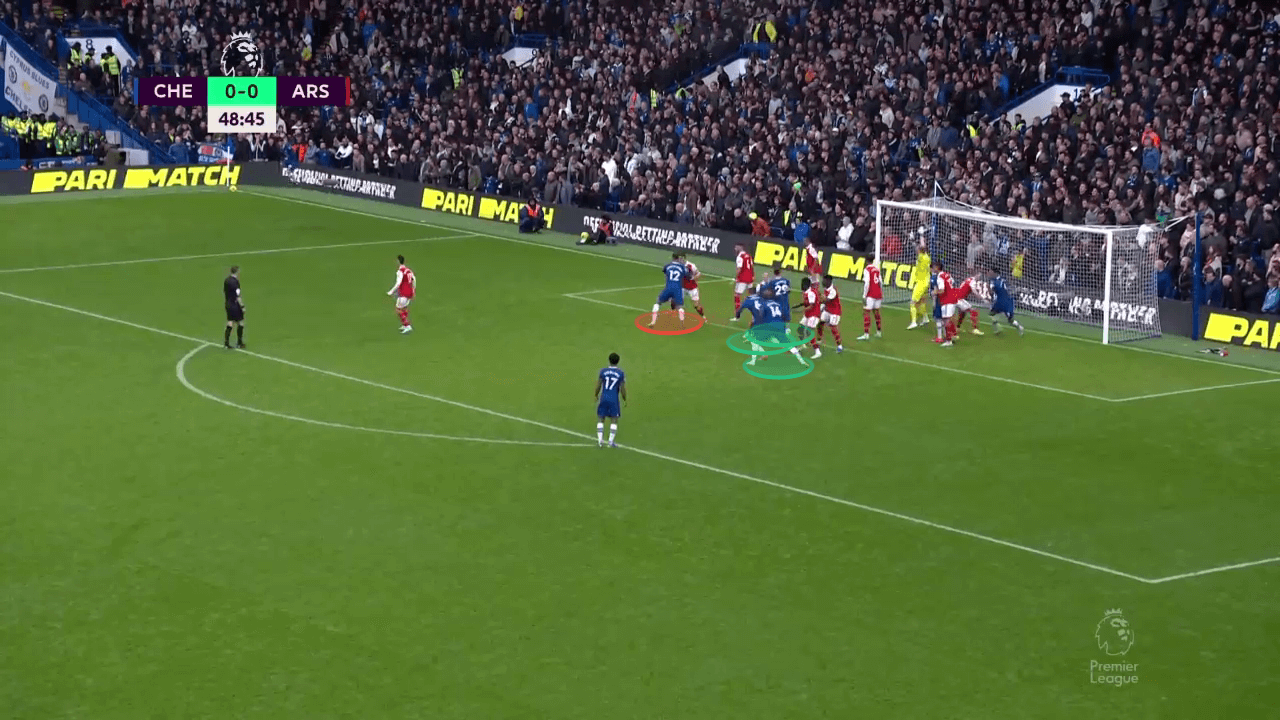
We can see below, how Thiago Silva (green) is tracked by three Arsenal (red) players. It is easy for the Arsenal defenders to track this run, as Silva is only two or three yards away when the corner is taken, and so it becomes impossible for Silva to dismark himself from three players when he has to move three yards. Had the run started from deeper, Silva would have only been marked by one player, and the extra distance would have made it easier for him to lose his marker.
Furthermore, the target area for the crosser of the ball would become bigger, as the Arsenal zonal markers would be more spread out. Chelsea laid their cards out on the table before the hand was dealt, and so became very predictable and easy to defend against.
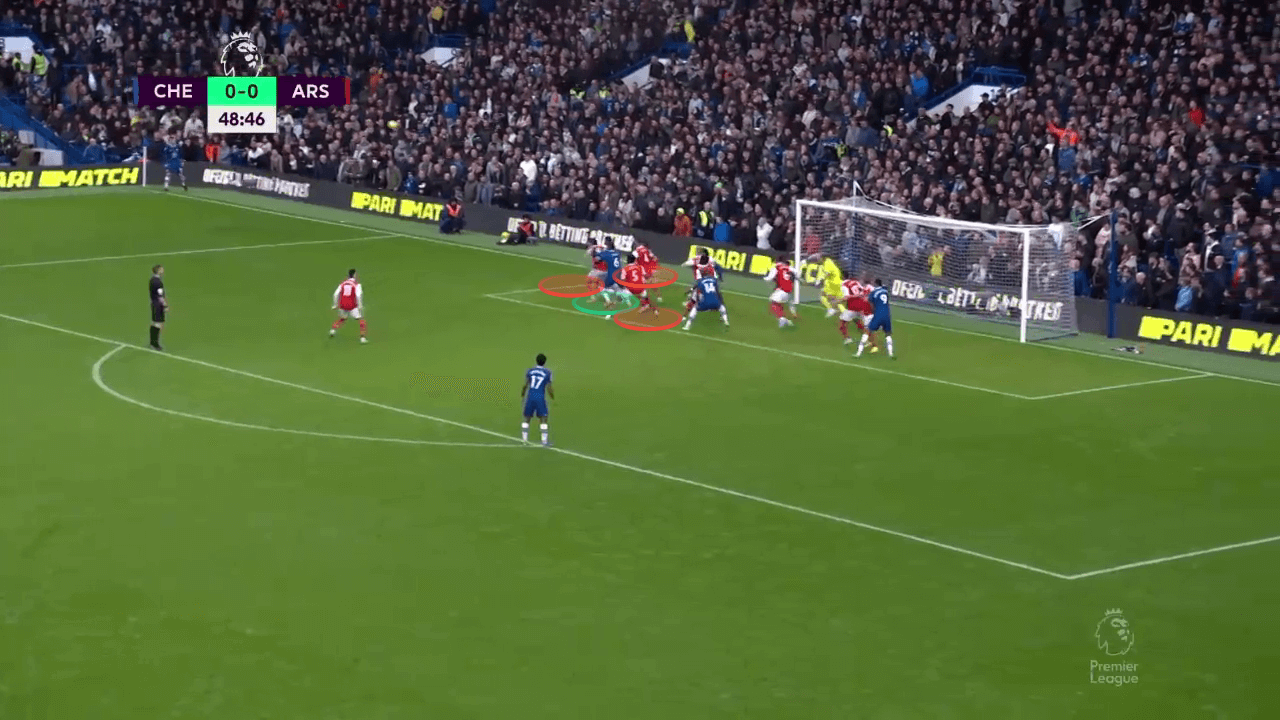
Ways Chelsea can improve against zonal defending
There are numerous ways that teams can exploit zonal defences. It’s important to mention that when we discuss this, it is more of a mixture between man and zonal markers, as no team in the current times only marks space zonally.
The most effective and common method of creating chances against this sort of defence is through crossing the ball into the front of the six-yard box, where a team flicks the ball towards the back post. Crossing the ball to the front edge of the six-yard box is easier in a way, as there are fewer defenders to bypass, but also has less room for error, so the deliveries have to be perfect.
The cross towards the near edge of the six-yard box is designed to be flicked on, in order to move the defensive line out of position. As the ball is crossed in, defenders move towards the ball, which opens up space near the back post for someone to attack the ball from deep.
We can see in the image below, all the different roles of the Chelsea players during the attacking corner. There are runners from deep (blue) who look to get to the second ball, Aubameyang (red) screens his marker, to prevent him from clearing the near post cross while Jorginho and Pulisic (green) attack the open space at the front edge of the six-yard box.
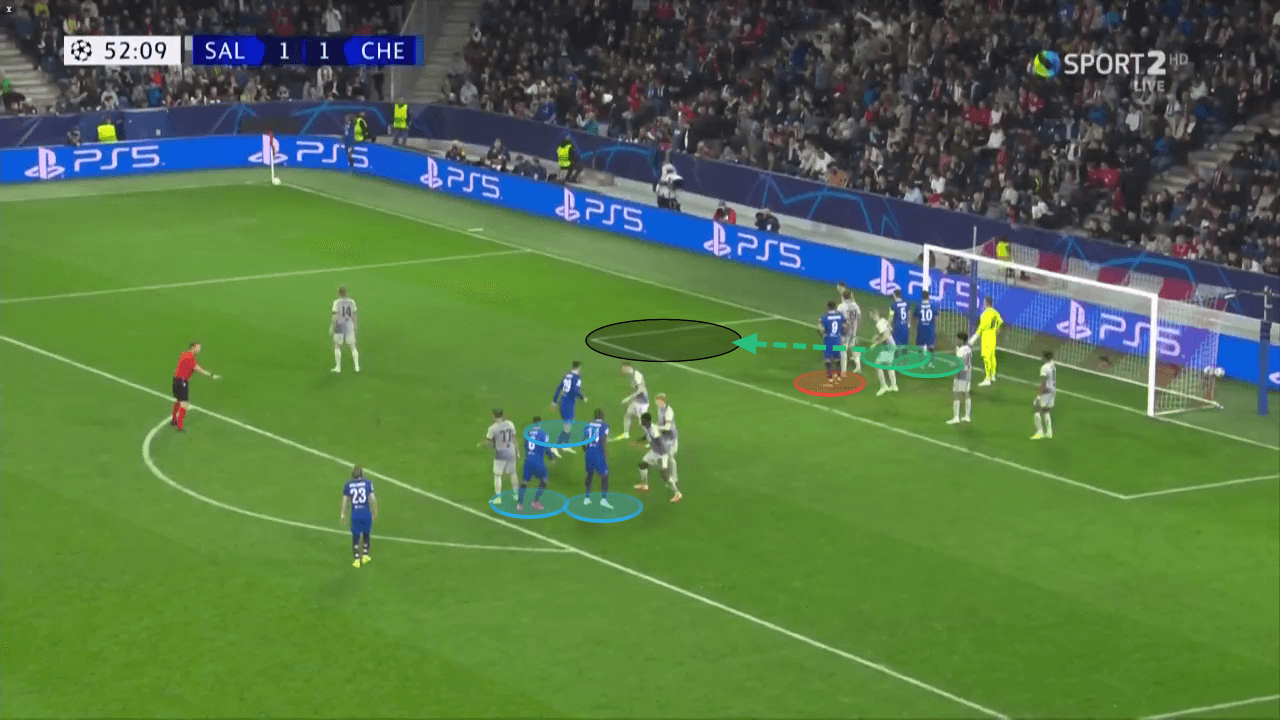
What Chelsea have done well on this occasion, is to double up on the near-post zonal defender. The two players in green above, surround one Salzburg defender. As the corner is taken, Pulisic (yellow) makes a decoy run away from the target area, to drag the zonal defender out of space. This creates space for Jorginho (green) to attack the cross unopposed from within six yards.
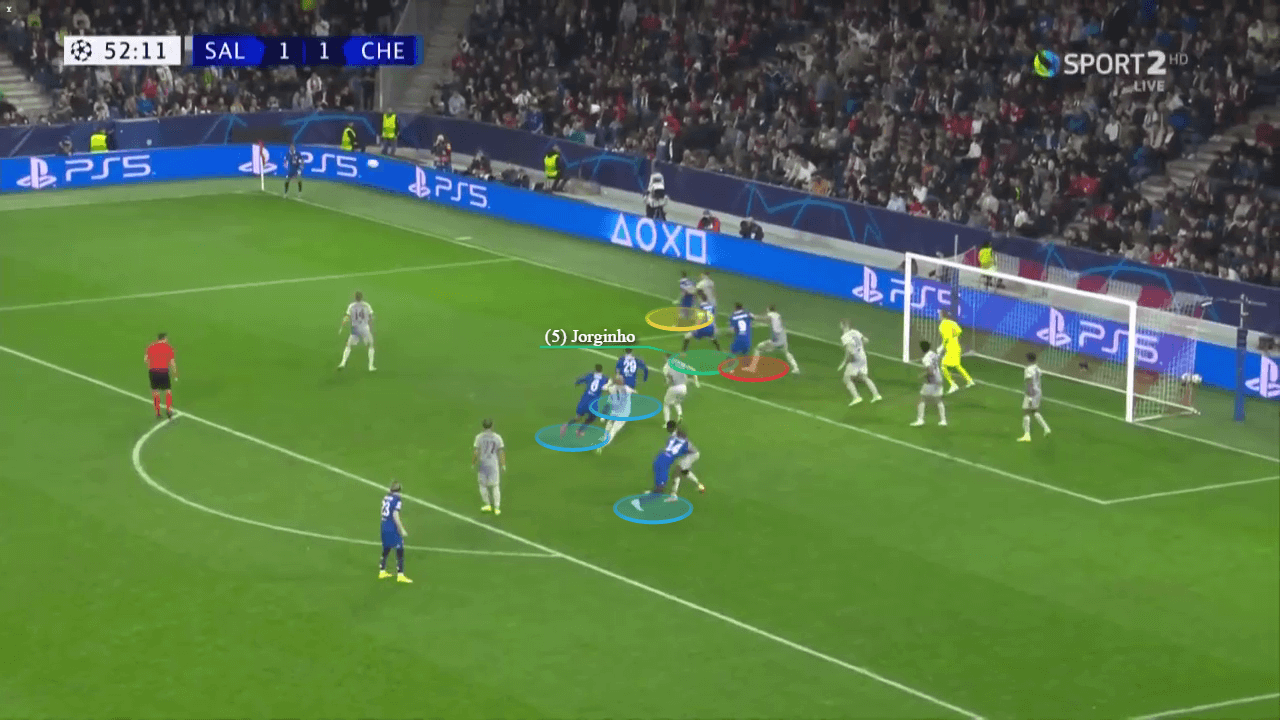
The issue with this routine for Chelsea is the lack of direction from the deep runners (blue) who run into each other’s paths. A well-planned out routine would result in the three runners all attacking the back half of the goal, all in different lanes, to make sure that there is someone there to get to the end of the flick-on should it be accurate. In this case, the flick-on was accurate, but two of the deep runners went to attack the first ball when it wasn’t their job.
Meanwhile, Chalobah, the third runner at the bottom, failed to dismark himself, which meant that he couldn’t get to the back post in time as his run was blocked off.
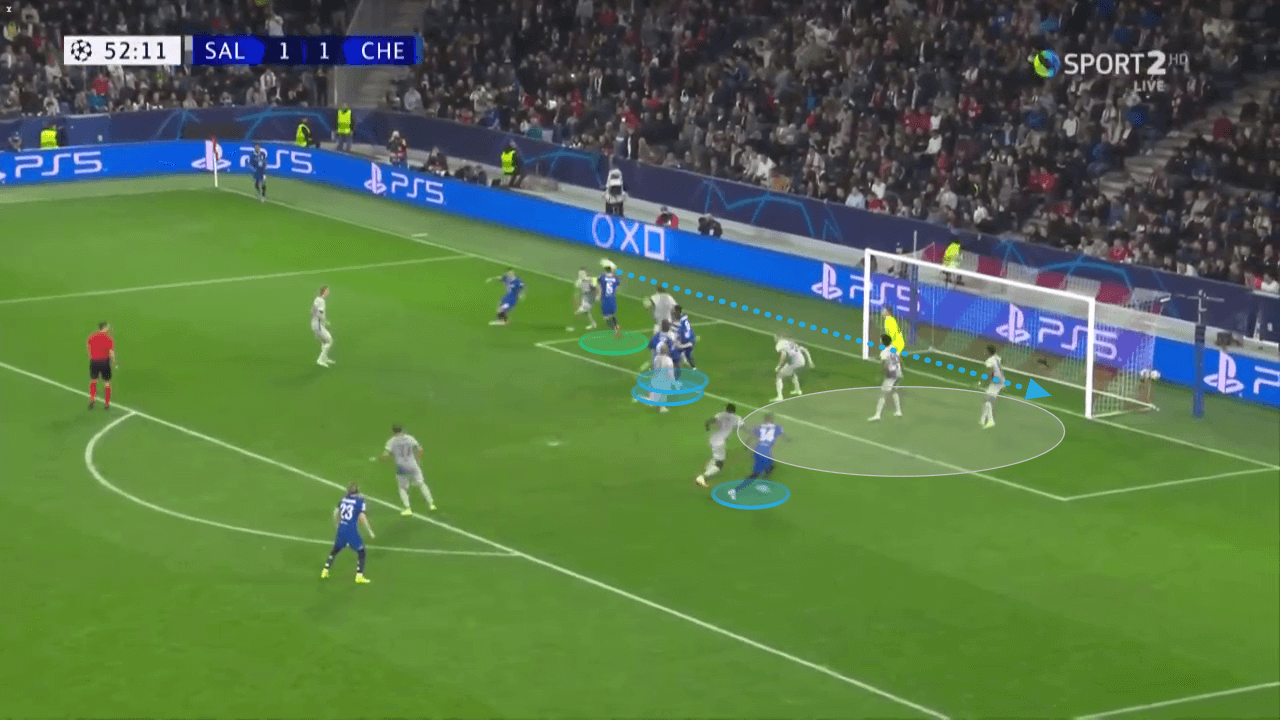
Another way in which Chelsea have created chances against deeper defences is by passing the ball to the edge of the box where the space is vacated. In the image below, Bournemouth don’t have any defenders on the edge of the box. Chelsea are smart to identify the open space and play the pass there, using Sterling’s dummy as a disguise to give Reece James more time on the ball. The corner is played well, but the shot is mishit.
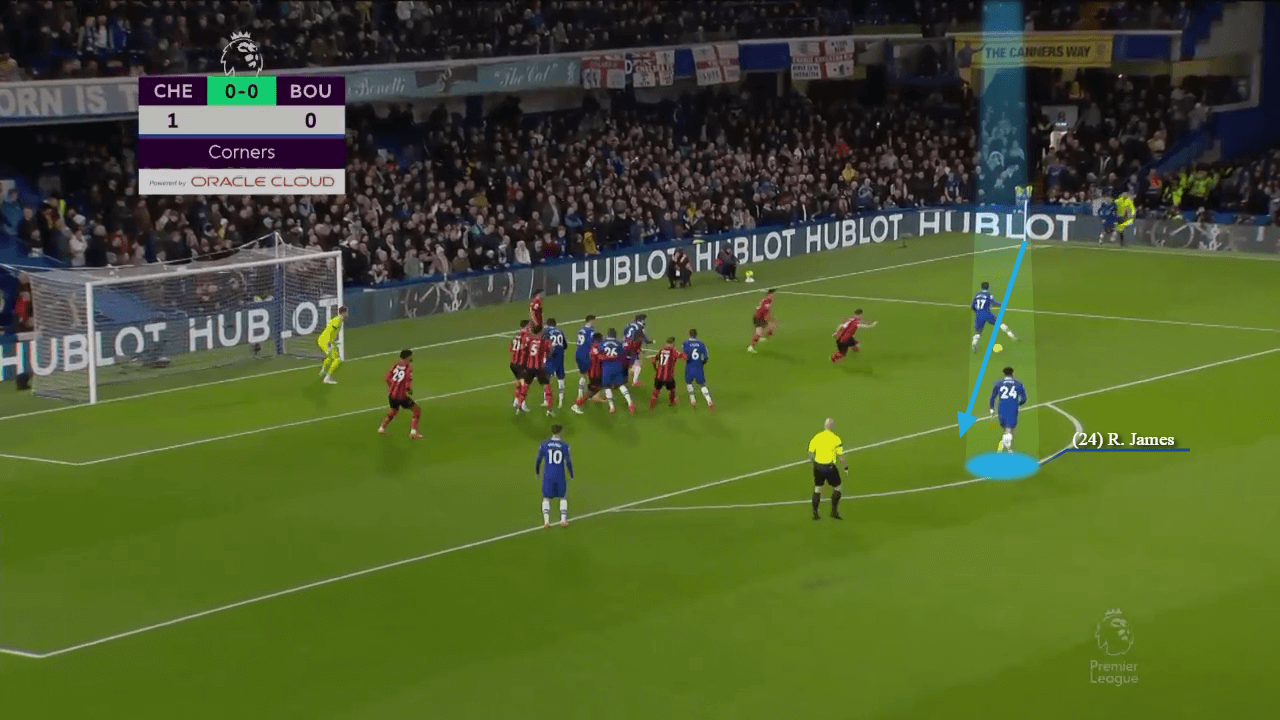
Chelsea have also managed to use this kind of routine against man-marking setups. When the defenders are further from goal, Chelsea have choreographed their use of screens to create space closer to goal. The blockers (red) all use their arms to hold the defender in place, while Aubameyang (blue) attacks the open space behind them.
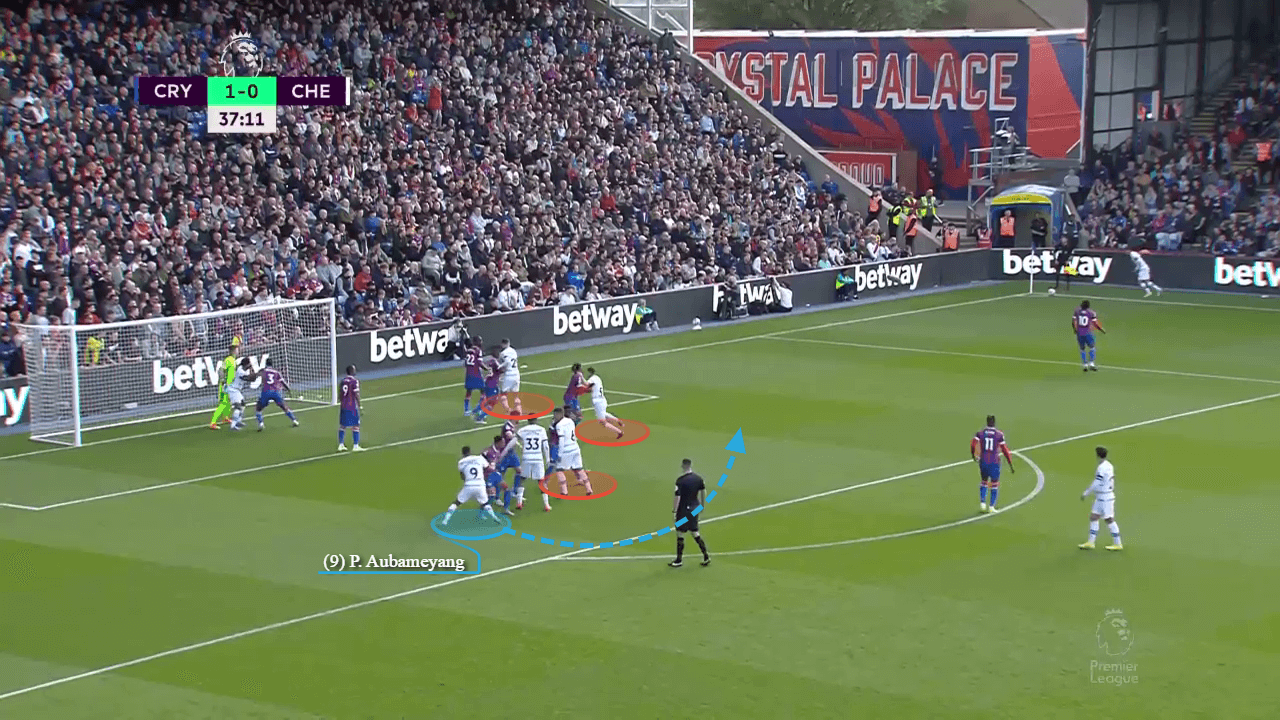
However, they are let down yet again by a poor finish, as the shot from 12 yards is mishit.
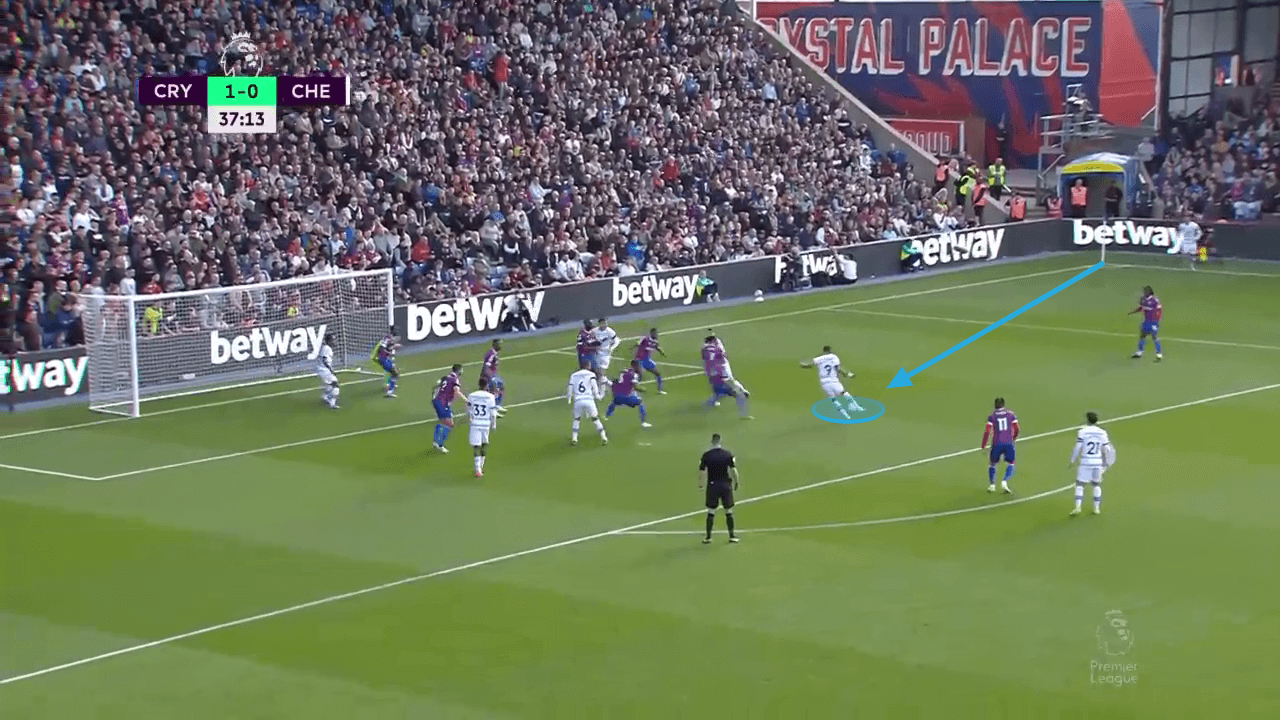
Lack of creativity against man-marking
Against man-marking setups, Potter places too much faith in the individual 1v1 quality of his players to beat their man markers. They rarely make use of screens or planned movements. Potter has been reliant on his players to beat defenders in aerial duels from unfavourable positions.
In the image below, we can see every player (blue) make the same run into a different area. The problem is that man markers find it easy to disrupt the runs, and so if a Chelsea player manages to jump over their markers, they will probably be off-balance and unlikely to score. Chelsea’s players lack the mobility to dismark themselves through body feints or quick movements.
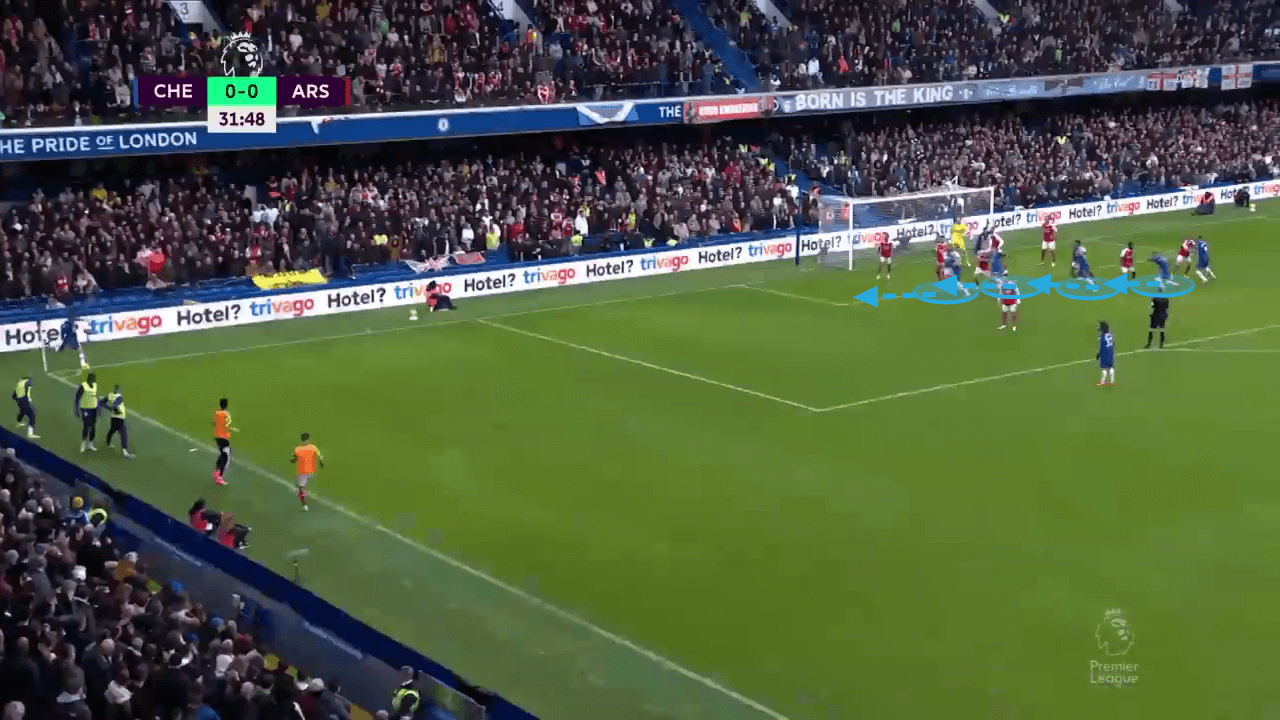
Below we can see Chelsea against a 10-man Milan side, where even with their advantage they can’t create a good goalscoring opportunity. The players are all spread out, meaning that there is no area in the box where Chelsea have an advantage. Like in open-play football, teams attempt to either create overloads or find isolated players, but Chelsea don’t attempt to do either.
There are many ways to create a space for someone to burst into, or to create an overload to increase the chances of winning the aerial duel. However, every Chelsea player seems to be in it for themselves, and none of them make unselfish actions to put someone else into a more favourable situation.
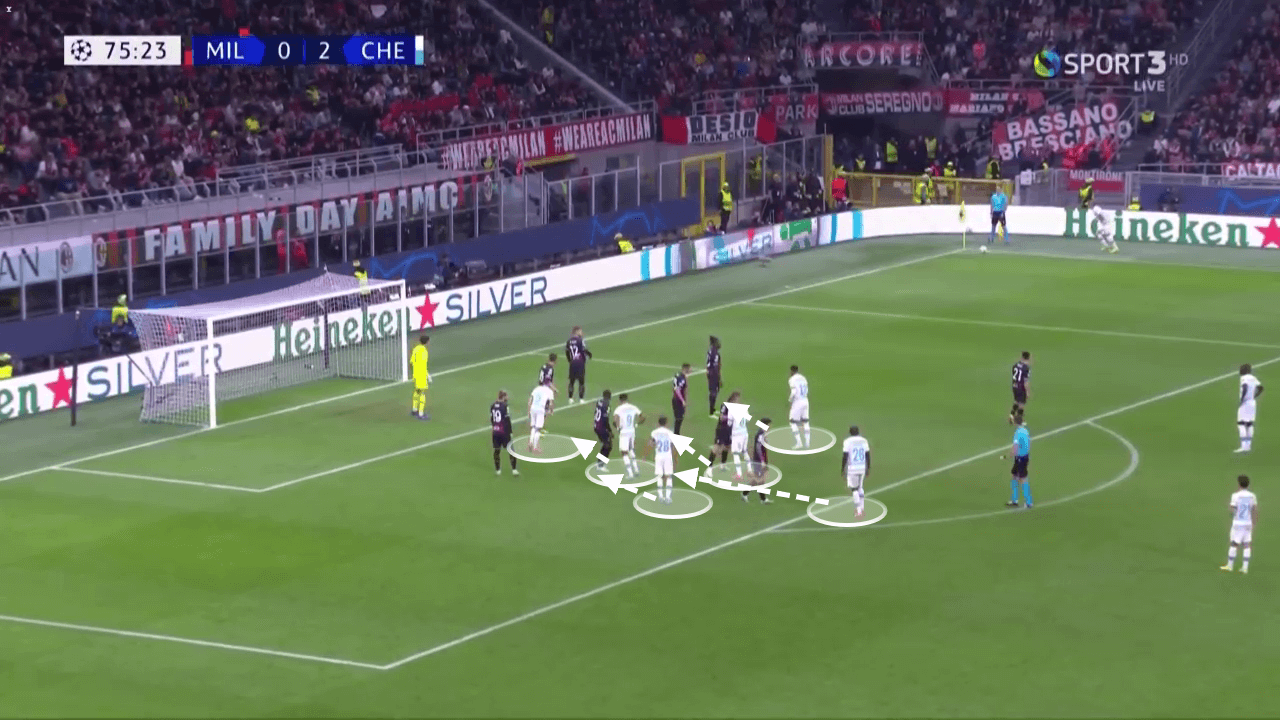
This image below shows how every player failed to dismark themselves from their defender, with every defender (red) staying goal side and in control of the situation apart from Tonali who lost control of Koulibaly (white).
Looking at the image above, we can see the difference between Koulibaly and the rest of the Chelsea players is the starting position. A run from deep allows you to have the run-up on your defender so that they can’t keep up with you over the next five yards. This is one way in which you can dismark your defender when 1v1. Every other Chelsea player fails to make any sort of quick movement to lose their marker, which can be hard when you are 1v1, which is why teams look to make routines where some players make unselfish movements to create space for certain players.
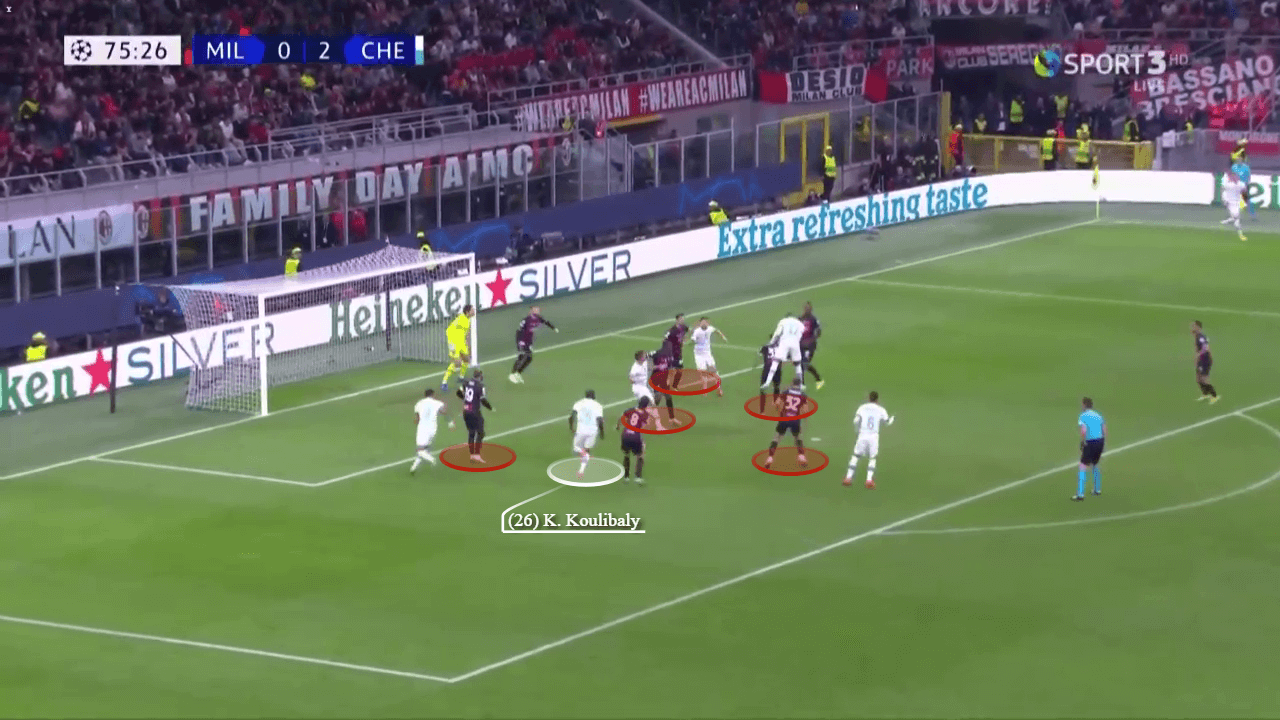
How can Chelsea improve against man-marking
Below we can see one way in which it is possible to make man-marking harder for opposition teams. Having players stay tight to each other means that defenders can’t man mark you, as there is physically no space to do so. This allows each Chelsea player to have extra space to run into, and have the momentum to win an aerial duel or lose their marker. This is one of the more common and effective ways, but one which Chelsea seem hesitant to usually do for some reason.
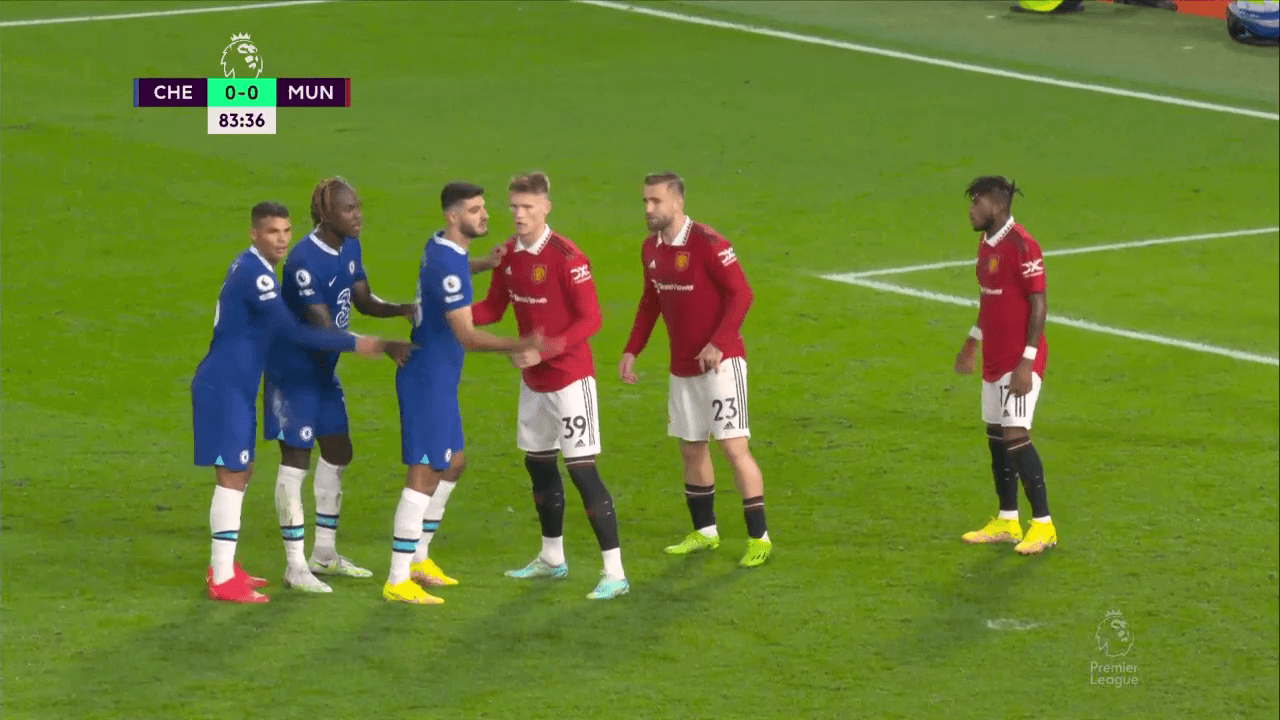
As the defenders can’t stay touch-tight, Broja can then make the run in front of McTominay, which causes him to grab Broja and give away a penalty. This move was also helped by Broja’s ability to dismark himself through the use of a body feint, which gave him an even bigger head start for the run at goal.
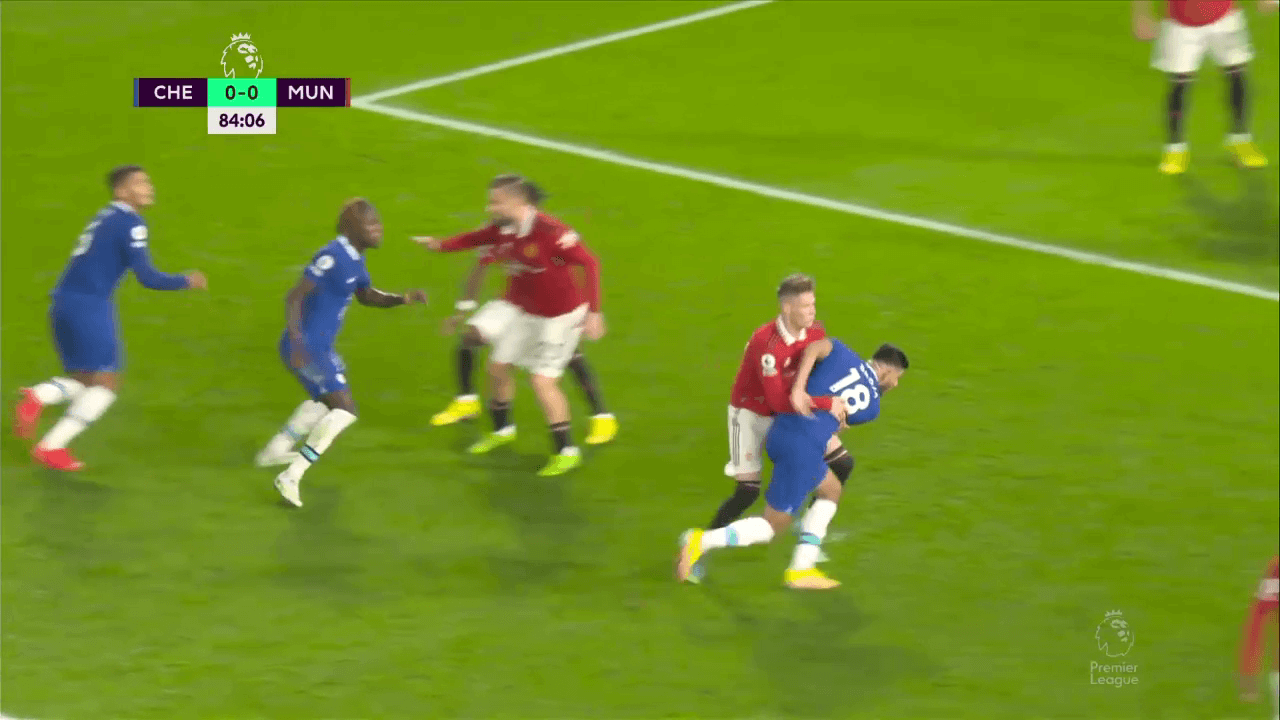
Below we can see one more final way in which Chelsea have shown that it is possible to create chances from corners. In the image, we can see the Chelsea players double-up on a Wolves defender. The defender (yellow) is marking Chalobah (blue) whilst Azpilicueta (red) is about to set up a screen. However, through Azpilicueta’s awareness, he realises that his man marker hasn’t followed him. He understands that he is unmarked, and so turns the screen into a fake one, where he allows the marked to follow Chalobah and instead, quickly turns to face the ball and goal.
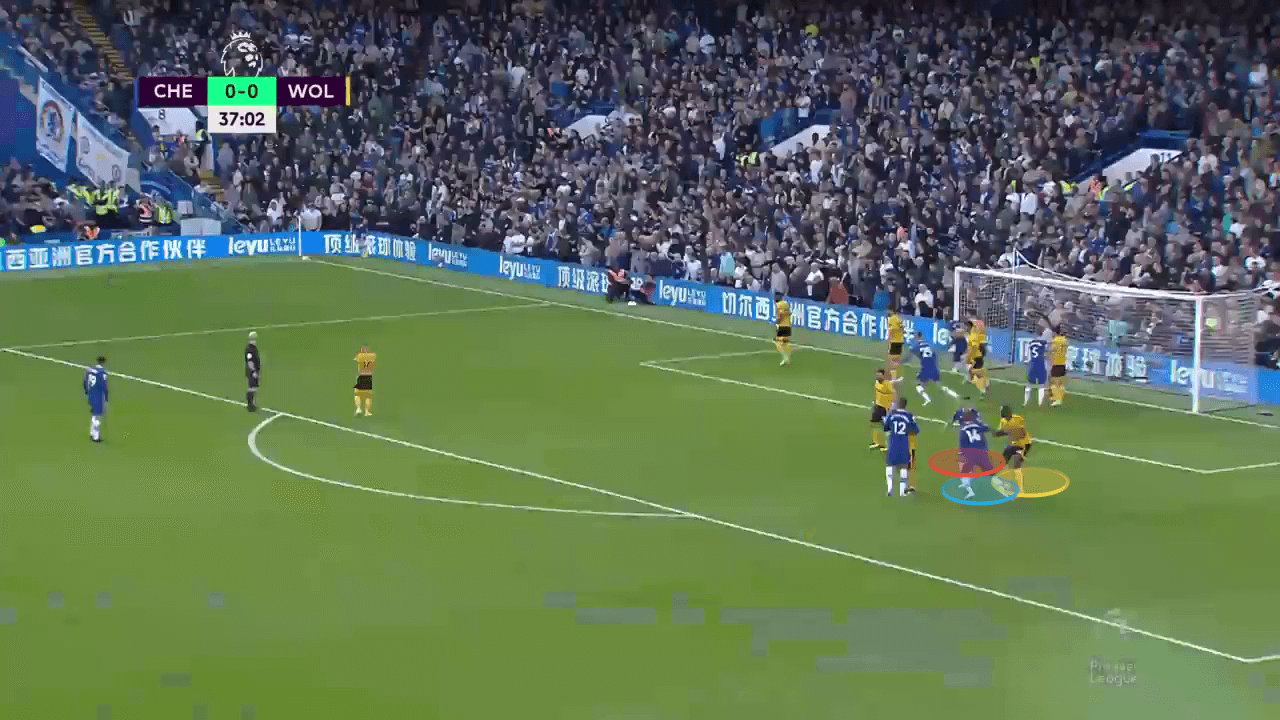
As a result, Azpilicueta ends up in open space at the back post, after the marker (yellow) started to follow the decoy runner. Another benefit of a back post cross is that it becomes very difficult for defenders to track both the ball and the runner. The defender can choose to mark the attacker by looking at him but would lose track of the ball, or he could choose to fixate his eyes on the ball, but that would allow his attacker to time the jump perfectly as there would be no one in the way.
Back post crosses are usually made even more effective when, like in the image below, someone screens the goalkeeper, forcing him to stay on his line and not be able to claim the cross. The defender (yellow) has no idea where Azpilicueta is, which allows him to have an easy attempt on goal, although he ends up missing the ball in the scenario below.
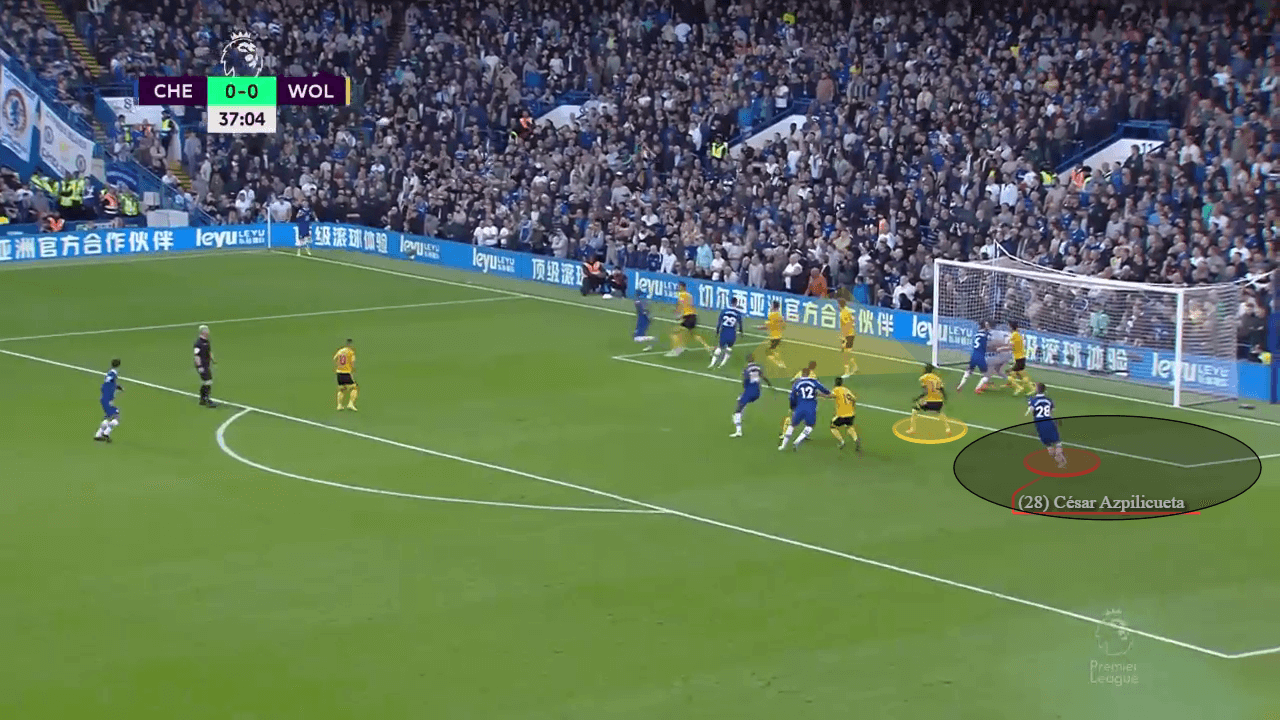
Summary
This set-piece analysis has displayed the different ways in which Chelsea have underperformed in dead-ball situations. There have been some clear issues with the methodology behind the set-pieces, although they have shown on occasions smart methods to create good chances. Chelsea clearly have the ability from dead balls, as they have shown, but there seems to be a lack of preparation as the majority of these set-pieces are either hit towards the wrong area, or players all make poor movements, making it easy to defend against.
Perhaps Potter has been more focused on introducing the team to other tactical parts of his game or he has lacked continuity due to constant changes in lineups due to injuries, making it hard to prepare plans when target players get injured. Nevertheless, Chelsea have to improve from set-pieces as it’s an area where crucial points can be won, and Chelsea earn more corners than most teams, so will continue to have many chances from these situations each game.
Keeping in line with recent backroom changes, maybe a set-piece analyst could come in and take the burden from Potter, and coach new corner routines for a team which has quality crossers of the ball, and some great headers of the ball. Right now, it looks like an area that has been overlooked, which shouldn’t be accepted for a club of Chelsea’s stature.






Comments